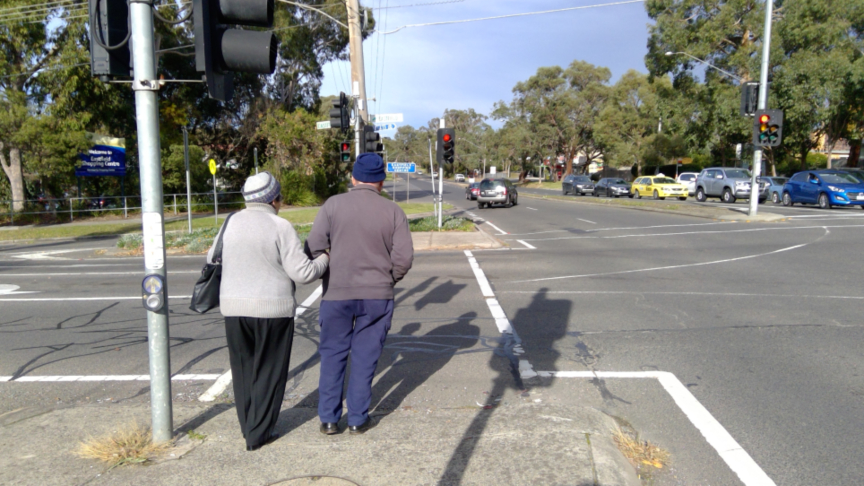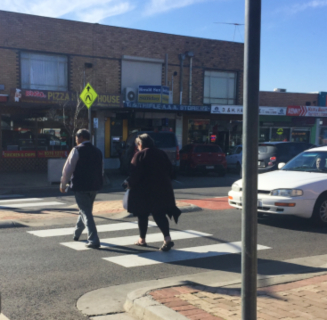Who has to give way? What if the road rules are unclear?

By the Roaming Lawyer - Megan Caines
The “entitlement” of drivers and what it means for people walking has been discussed widely in the media recently. I had my own personal brush with entitlement recently, so I’m feeling the need to comment.
A few weeks ago, I was out for a walk. I was enjoying a podcast in my headphones, but aware of my surroundings, and alert to what was happening on the roads around me. After making sure that it was safe to cross, I stepped into an intersection when a car approached rapidly from behind me and indicated to turn left. The driver beeped at me and yelled from his window, “You don’t have right of way you know!?” I paused on the road to allow him to turn in front of me, as he was obviously in a hurry and a bad mood. However, it was only after he had passed me that I noticed an elderly gentleman who, with the use of a walking frame, had been about to cross the road from the other side, and could easily have been struck and quite possibly injured by the car. As the car sped off down the street, the elderly gentleman just shook his head and kept walking.
Was the driver right? Did he have right of way?
The short answer is no, he didn’t.
While it is generally our custom in Australia for pedestrians to give way to vehicles, rule 69 of the Road Safety Rules 2009 states that when turning left or right at an intersection, drivers must give way to any pedestrians at or near the intersection who are crossing the road which they are turning into.
Therefore, not only was the driver obliged to give way to me, he was also obliged to give way to the older gentleman. As he failed to give way to both of us, he was in breach of the road rules.
Other situations where the road rules make it very clear that drivers have to give way to walkers include:
- At pedestrian crossings
- When using a slip lane
- When a driver is performing a U-turn
- In shared zones (signed with a shared zone sign, such as school roads leading into schools).
For some very handy information regarding some of the road rules as they apply to pedestrians, check out the Victoria Walks Walking Law webpage.
But what about situations where the rules are less clear?
For example, what if instead of crossing at or near the intersection, I had been crossing the road 35 metres away from the intersection?
In that scenario, the first question to be considered is, am I breaching the road rules? The answer according to the Road Safety Road Rules 2009 (specifically rule 234) is that if there is a crossing within 20 meters of me I am required to use that crossing, and if there is not, I am required to use the shortest and most direct route to cross the road. But this does not mean I don’t have to give way, and I still have an obligation not to create a hazard to other road users – a duty of care to anyone else who may be using the road with me.
What is a duty of care?

It is well established in case law that all road users owe other road users a duty of care, which means that drivers are obliged to make reasonable efforts to avoid injuring other road users with their vehicle. However, pedestrians also owe other road users a duty of care, and, additionally must take reasonable care for their own safety.
The responsibility of the driver to take care is greater than that of the pedestrian. This is because drivers are in control of a vehicle which can cause significant harm to others, and should act accordingly. Regardless of who has to give way, if a driver collides with a pedestrian that they could have avoided, they are likely to be considered to have been in breach of their duty of care to the pedestrian. In other words, regardless of the technical road rules, if the elderly gentleman above had been struck and seriously injured by the car, and came to see me for some advice, I would encourage him to make a claim for compensation with the TAC on the basis that the driver was negligent.
How do the road rules interact with the duty of care?
None of us, including pedestrians and drivers, fully satisfy our duty of care just by following the road rules. Even when we are abiding by the road rules, we need to take care to avoid foreseeable risks. For example, a driver travelling within the speed limit is still required to be on the lookout for pedestrians. Even if a pedestrian was crossing against a red man and is hit by a car, the driver will still be found to have acted negligently if there was an opportunity to observe the pedestrian and avoid the collision.
And by the time I’d finished explaining all of this, the angry driver of the car was far, far down the road.
The Roaming Lawyer

Megan Caines is a Senior Associate at Polaris Lawyers, who has acted for hundreds of pedestrians injured on Victorian roads. She is passionate about the rights of people injured on the road and in the work place.
Do you have a legal question about walking (a general issue, not specific to your personal circumstances)? Contact us at Victoria Walks and we'll see if we can answer it in a future column.